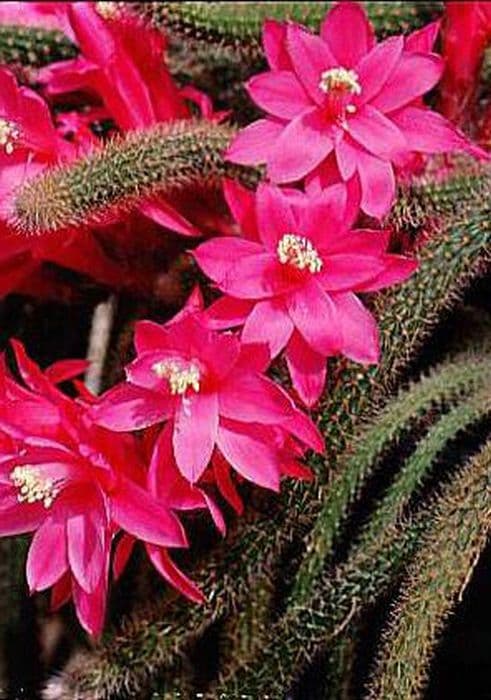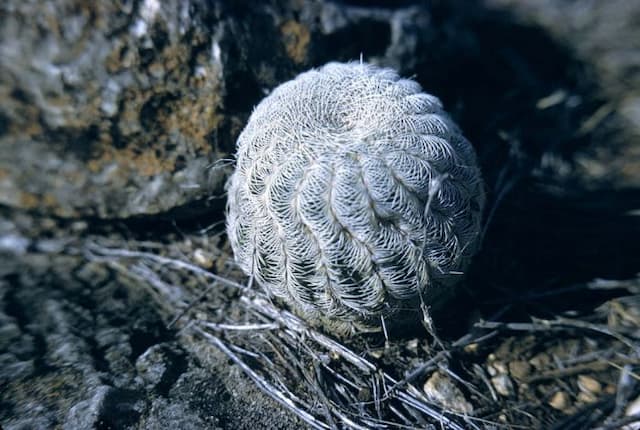Golden Barrel Cactus Echinocactus grusonii

ABOUT
The plant commonly known as the Golden Barrel Cactus has a striking and distinctive appearance, characterized by a rounded, globular shape that readily invokes the image of a barrel. This squat and plump form evokes a sense of robustness and solidity. The surface is segmented into prominent ribs that run vertically from the top to the bottom, giving the plant a pleated look. The cactus is covered in clusters of long, sharp spines that provide a dramatic contrast to its green, sometimes glaucous, skin. These spines are yellow to white in color, lending the plant its 'golden' moniker and providing an almost aureate glow when they catch sunlight. At the top of the cactus, there is a wooly cap where the new spines emerge, adding a soft texture juxtaposed against the rigid spikiness. The Golden Barrel Cactus is sculptural in its form, offering an aesthetic that has often been associated with desert landscapes. Despite its harsh, spiny exterior, the plant is sometimes crowned with a ring of vibrant yellow flowers that sit like a halo atop the cactus during blooming season, adding a touch of beauty to its otherwise formidable appearance.
About this plant
 Names
NamesFamily
Cactaceae
Synonyms
Golden Barrel Cactus, Mother-In-Law's Cushion, Golden Ball, Mother-In-Law's Seat
Common names
Cereus grusonii, Echinocactus grusonii var. albispinus, Echinocactus grusonii f. albispinus, Echinocactus grusonii var. brevispinus, Echinocactus grusonii f. brevispinus, Echinocactus grusonii var. intertextus, Echinocactus grusonii f. intertextus, Echinocactus grusonii var. multiplex, Echinocactus grusonii f. multiplex, Echinocactus grusonii var. subinermis, Echinocactus grusonii f. subinermis, Echinofossulocactus grusonii, Malacocarpus grusonii, Ferocactus grusonii.
 Characteristics
CharacteristicsLife cycle
Perennials
Foliage type
Evergreen
Color of leaves
Green
Flower color
Yellow
Height
2 feet [60 cm]
Spread
2 feet [60 cm]
Plant type
Cactus
Hardiness zones
9
Native area
Mexico
Benefits
 General Benefits
General Benefits- Decorative Appeal: Echinocactus grusonii, commonly known as "Golden Barrel Cactus," is a spherical, visually striking plant with a ribbed surface and spiky appearance that is often used in decorative settings and as a focal point in gardens.
- Drought Resistance: The Golden Barrel Cactus is highly drought-tolerant, making it an ideal plant for water-wise gardens and xeriscaping in arid environments.
- Easy Maintenance: This cactus requires minimal care, thriving in full sun with little watering, and is a good choice for novice gardeners or those seeking low-maintenance plants.
- Longevity: The Golden Barrel Cactus has a long lifespan, often living for decades, providing a long-term presence in gardens and landscapes.
- Resilience to Pests: Being a desert plant, it is naturally resistant to many pests and diseases, reducing the need for chemical treatments.
- Ecological Support: Its flowers and fruits can provide food for native wildlife such as birds and bees in its natural habitat.
 Medical Properties
Medical PropertiesThis plant is not used for medical purposes.
 Air-purifying Qualities
Air-purifying QualitiesThis plant is not specifically known for air purifying qualities.
 Other Uses
Other Uses- The Golden Barrel Cactus can be used as a natural barrier or fencing alternative due to its spiny exterior, deterring animals and unauthorized people from entering sensitive areas.
- In landscaping, the cactus can serve as a dramatic focal point in rock gardens, adding texture and contrast to the environment.
- Creative artists and craftsmen may utilize dried Golden Barrel Cactus specimens as unconventional canvases for painting or as decorative sculpture bases for a unique aesthetic.
- Its spherical shape and patterned texture make the Golden Barrel Cactus a popular subject for photographers and painters who are interested in capturing the beauty of desert flora.
- During drought or water-use restrictions, the Golden Barrel Cactus is often planted as an alternative to more water-intensive greenery, contributing to water conservation efforts in landscaping.
- Its symmetrical shape makes it an educational tool for demonstrating radial symmetry and Fibonacci sequences found in nature to students and nature enthusiasts.
- Certain cultural ceremonies may incorporate the Golden Barrel Cactus as a symbol of resilience and adaptation to harsh conditions.
- In eco-friendly construction, parts of the cactus may be employed in creating green roofs or living walls, integrating xeriscaping principles.
- As a natural form of pest control, the cactus's sharp spines can help protect nearby plants from small animals and insect pests.
- The sturdy structure of the Golden Barrel Cactus is sometimes used in crafting, where it can serve as a natural pin cushion or decorative needle holder for sewing and embroidery.
Interesting Facts
 Feng Shui
Feng ShuiThe Golden Barrel Cactus is not used in Feng Shui practice.
 Zodiac Sign Compitability
Zodiac Sign CompitabilityThe Golden Barrel Cactus is not used in astrology practice.
 Plant Symbolism
Plant Symbolism- Resilience: Echinocactus grusonii, also known as Golden Barrel Cactus, is symbolic of resilience as it thrives in harsh desert climates by storing water and adapting to extreme conditions.
- Protection: With its sharp spines, the Golden Barrel Cactus represents a form of natural protection, serving as a reminder to guard oneself from life's metaphorical threats.
- Conservation: As a species that is often protected due to its vulnerable status in the wild, the Golden Barrel Cactus symbolizes the importance of conservation and preserving natural habitats.
- Endurance: The long lifespan and slow growth rate of the Golden Barrel Cactus stand for endurance and patience, showing that some aspects of life require time to come to fruition.
- Beauty in Adversity: Despite originating from unforgiving environments, the Golden Barrel Cactus is admired for its striking appearance, symbolizing the concept of finding beauty even in difficult situations.
 Water
WaterThe Golden Barrel cactus requires watering every two to four weeks during the active growing season in spring and summer, depending on the humidity and temperature. Allow the soil to dry out completely between waterings. When you do water, provide enough water so that it runs through the drainage holes—this might be around two gallons for a large cactus. In the dormant winter period, reduce watering to once a month or less, being cautious not to overwater and cause root rot.
 Light
LightThe Golden Barrel cactus thrives in bright, direct sunlight. It requires at least six hours of sunlight per day, thus placing it in a south-facing window is ideal. If outdoors, ensure it is in a location where it receives ample sunlight throughout the day without any shading from trees or structures.
 Temperature
TemperatureThe Golden Barrel cactus prefers temperatures between 50 to 75 degrees Fahrenheit and can withstand short periods of frost down to 20 degrees Fahrenheit. However, ensure it is protected from prolonged cold as it can damage the cactus. The ideal growing temperatures are warm and consistent, avoiding extreme fluctuations.
 Pruning
PruningPruning is not generally required for the Golden Barrel cactus as it maintains its spherical shape naturally. Any dead or damaged spines can be removed gently, but overall pruning is unnecessary. If offsets appear and you wish to propagate or tidy the cactus, this can be done during the warmer months.
 Cleaning
CleaningNot needed
 Soil
SoilThe Golden Barrel Cactus thrives in a well-draining cactus mix with perlite or sand to improve drainage, with an ideal soil pH between 6.0 and 7.5 for optimal growth.
 Repotting
RepottingThe Golden Barrel Cactus should be repotted every three to four years or when it outgrows its container, whichever comes first, doing so during the warm season.
 Humidity & Misting
Humidity & MistingThe Golden Barrel Cactus prefers low humidity levels typical of arid environments; it does not tolerate high humidity well.
 Suitable locations
Suitable locationsIndoor
Place Golden Barrel in bright light, away from drafts, water sparingly.
Outdoor
Plant in full sun, protect from heavy rain, and well-draining soil.
Hardiness zone
9-11 USDA
 Life cycle
Life cycleThe life of the Golden Barrel Cactus (Echinocactus grusonii) begins with seed germination, which is highly dependent on temperature and can take anywhere from weeks to several months. Once the seedling emerges, it enters a slow growth phase, characterized by the development of its spiny ridges and the iconic spherical shape. As a juvenile, the cactus continues to grow slowly, often taking several years to reach a few centimeters in diameter. In adulthood, which can take 10 to 30 years, the Golden Barrel may bloom with yellow flowers near the crown of the plant, generally in the summer. After pollination, fruit development occurs, housing seeds for dispersal. The Golden Barrel Cactus can live for up to 30 or more years in the wild, eventually reaching maturity with a diameter of up to 90 cm and a height of up to 1 meter.
 Propogation
PropogationPropogation time
Spring-Early Summer
The Golden Barrel Cactus (Echinocactus grusonii) is typically propagated through the sowing of seeds, which is the most popular method due to the plant's slow growth rate and difficulty with other propagation methods like cuttings. The best time for propagation by seeds is during the warm season when temperatures are consistently above 70 degrees Fahrenheit (21 degrees Celsius). To propagate, fill a shallow container with a well-draining cactus mix, scatter the seeds evenly over the surface, and then lightly cover them with a layer of sand or fine gravel. Keep the substrate slightly moist and provide a warm, bright environment without direct sunlight. Germination can take anywhere from a few weeks to several months, and it is crucial to maintain consistent conditions and patience as this process unfolds. Once the seedlings are large enough to handle, they can be transplanted into individual pots to continue growing.









